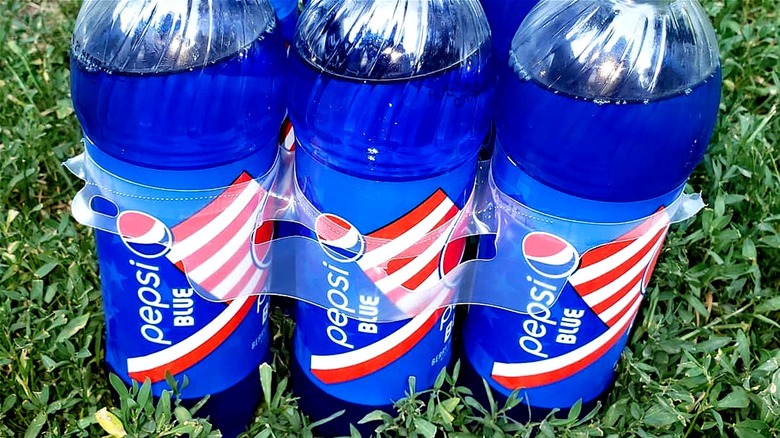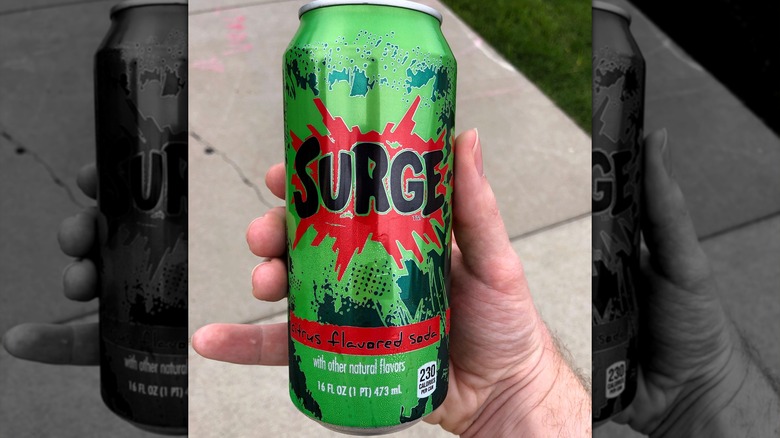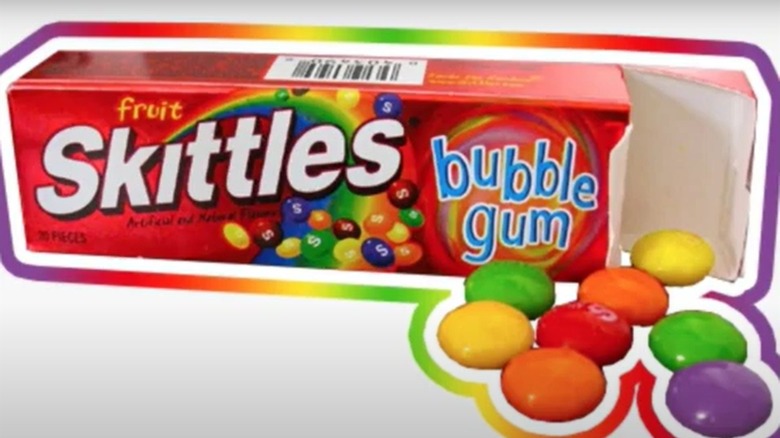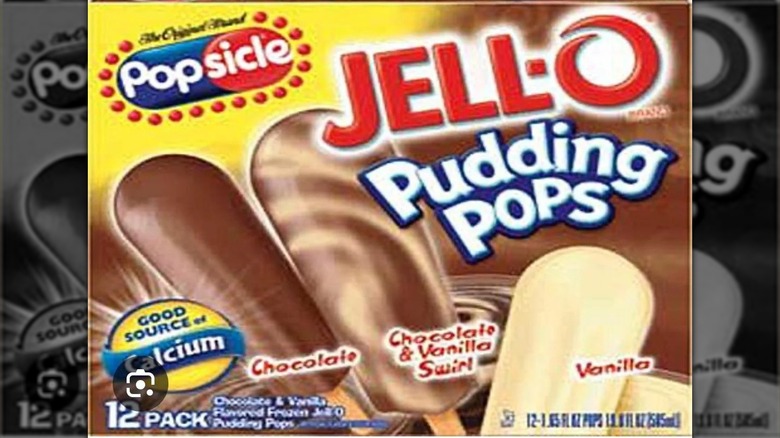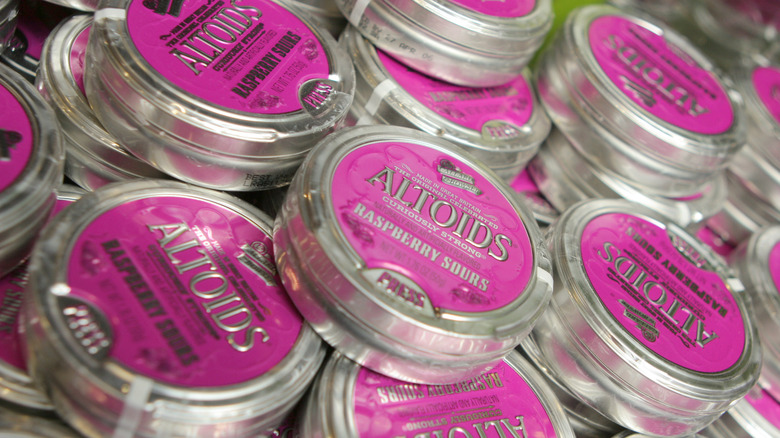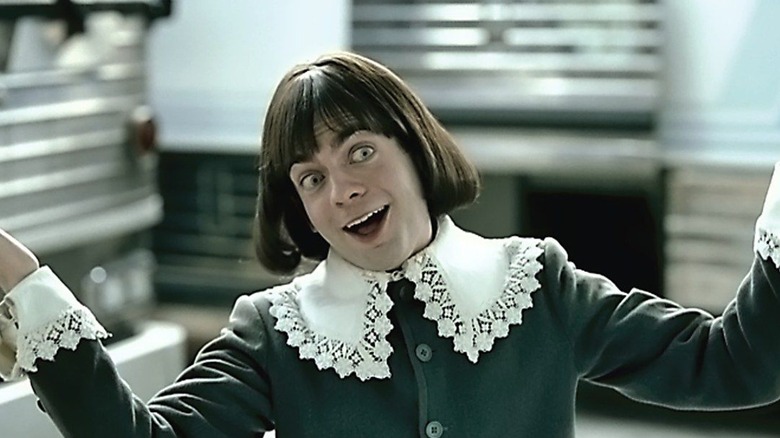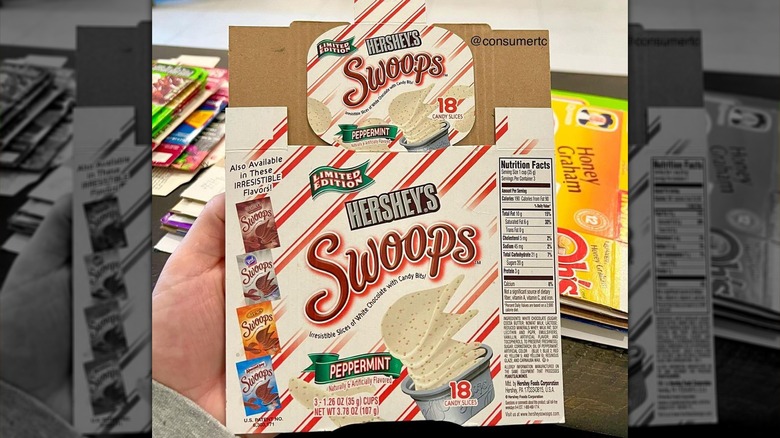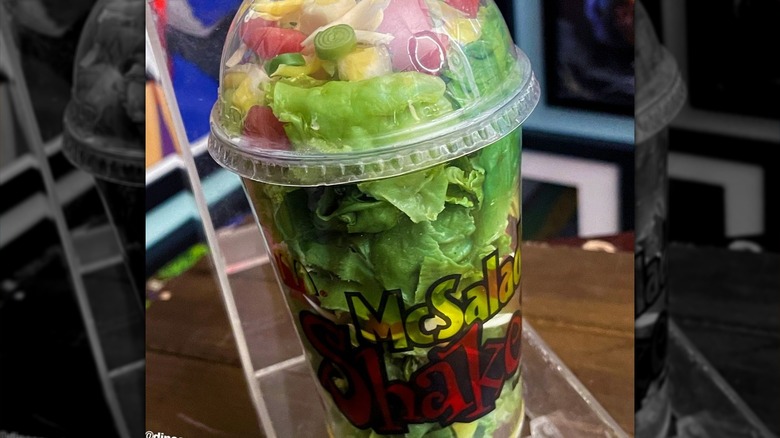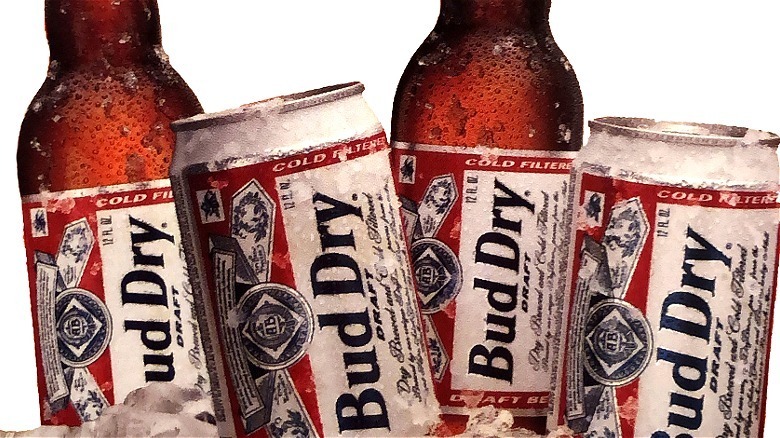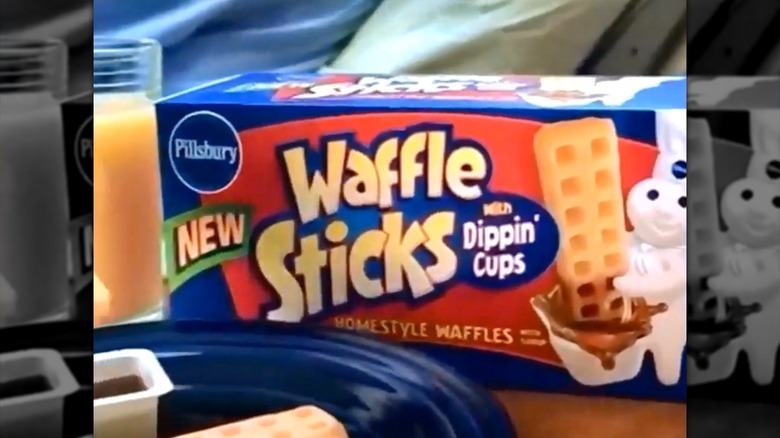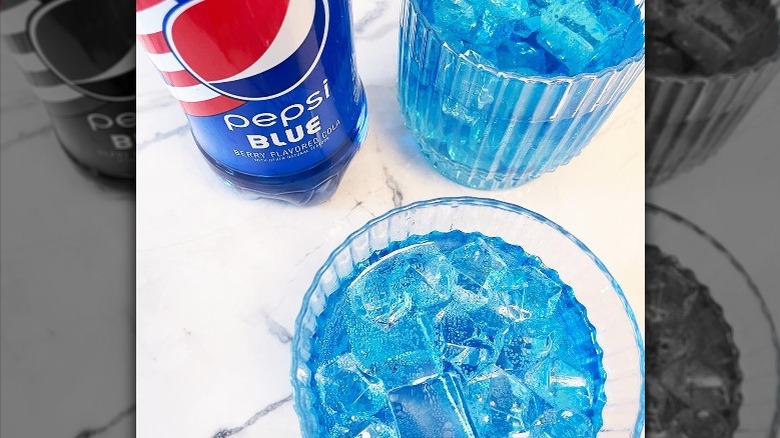10 Discontinued Foods From The 2000s You May Sadly Never Eat Again
In this world, nothing is guaranteed. People, places, and, yes, food that we love can be here one day and discontinued the next. It's a tragic fact but one we must learn to live with. We are a nostalgic species, and certain foods from childhood can remind us of simpler times — or, at the very least, put a smile on our faces. Keep smiling because, in the age of social media, the power is (sometimes) in the hands of the consumer. Many of our favorite snacks from yesteryear pop up again now and again, sometimes for a limited time, after successful campaigns from longtime fans.
So, as we reminisce through this list of 10 discontinued 2000s snacks — including everything from Altoid sours to Pillsbury waffle sticks — don't worry that you will never get the chance to eat these again. Be thankful that you were once given the opportunity, and stay hopeful for the future. Here are 10 fan favorites from the 2000s that were discontinued — and why.
1. Surge Soda
Surge soda is the personification — or perhaps the sodafication — of the 2000s. Just the can alone, with the name "Surge" written in a font that can only be described as a teenage boy's hand-written bubble lettering, which is, for some reason, exploding out of the harsh green-on-green background of the can. It's hard to imagine the 2000s without thinking about Surge soda because it garnered a cult-like following that lasted long after 2003, when the soft drink became almost impossible to find.
Surge was born as Coca-Cola's answer to Pepsi's increasingly popular Mountain Dew. Coke's new bright green beverage was less caffeinated than Mountain Dew, but the name Surge insinuated that it contained a lot of caffeine and sugar. The marketing for Surge, which was mostly aimed towards pre-teens, also depicted their product as a "fully loaded citrus soda," (via The Surge Movement). Eventually, the tides turned against Surge as mothers and schools across America began to boycott it, citing the unhealthy ingredients. Sales began to decline swiftly, and by 2003, Coca-Cola had officially discontinued Surge soda.
2. Skittles Gum
Skittles is still a popular candy brand today, especially around Halloween. Since the 2000s, not much has changed with their flagship red bag besides a controversial flavor switch from lime to green apple and back again. Starting in 2004, though, they tried to expand their expertise into the bubblegum game. Owned by Mars Wrigley (owners of Doublemint and Big Red), Skittles' foray into bubble gum seemed natural.
The new product looked just like the classic candy but had a lot more chew and less sweetness. As with many gum brands of the time — like Juicy Fruit, Fruit Stripe, or Chicklets — Skittles Gum lasted a few seconds before losing its flavor, leaving you chomping on a sticky, slightly stringy mess. The flavors were identical to the red candy bags, but people's appetites for the new product weren't the same. Compared to other products, it's likely the product was discontinued because sales were never spectacular; admittedly, it was not their best product. Still, Skittles gum lasted six whole years before finally being discontinued in 2010.
3. Jell-O Pudding Pops
Jell-O Pudding Pops were centaurian: part ice pop, part chocolate boxed pudding. While biting into a traditional ice pop may hurt those with sensitive teeth, biting into a Jell-o pop was like biting into a little piece of soft, slightly chewy heaven.
Jell-O's pudding pops were extremely popular throughout the early 2000s. Unfortunately, despite massive sales, Jell-O's parent company was not equipped to manufacture and store frozen treats efficiently enough. Jell-O's Pudding Pops were costing General Foods more than they were raking in, and another popular brand of the time ended up taking them over.
In 2004, the Jell-O Pudding Pop name was licensed to the Popsicle brand and remained in the freezer section for the rest of the 2000s before being discontinued around 2011. Fans of the original pudding pops claimed that these Popsicle-branded pudding pops just weren't the same. The new version elongated the pop, changing the recognizable wide and rounded shape. There were also slight changes to the texture and taste, turning the treat more into a fudgesicle than actual pudding.
4. Altoid Sours
Altoids are mints that are still widely sold today, mostly in the check-out lines of various grocery and convenience stores across the United States. Altoids Sours, though, became an unlikely underdog and, following their discontinuation, one of the most talked-about candies of the 2000s.
Altoids Sours came in a plethora of different flavors: tangerine, mango, apple, raspberry, and lime. However, according to a representative from Mars, Altoids' parent company, all five flavors were discontinued in 2010 due to low sales. People must not have known what they were missing until they were gone because there was a major push to bring back the sour, hard candies in the decade that followed.
Millennials, who were still growing up in the mid-2000s, were particularly pressed to see their favorite Altoids Sours return now that they had disposable income to spend on candy. Old photos of the mint tins became popular on social media sites like TikTok and Reddit. In the middle of 2024, Altoids announced the company would release Retro Sours, a play on the 2000s classic. Early reviews said they were not exactly the same as the originals, with one Instagrammer saying, "Not the same. We want the OG packaging as well." But they were pretty darn close.
5. Starburst Berries & Crème
Everyone alive in 2007 remembers the Starburst berries & crème commercial. Just hearing the phrase "berries and cream" invokes the thought of Him. To this day, the Little Lad still haunts many of our darkest nightmares and wildest dreams. Sadly, the catchy jingle was the most memorable part of the Starburst berries & crème rollout, as the new flavor hit the markets with a whimper instead of a bang.
Classic Starburst flavors, including cherry, orange, strawberry, and lemon, still exist today. We'll let you battle it out for which flavor is the best (or the worst.) What we do know is that none of the berries and crème flavors were as beloved as the originals. The new variety pack came with mixed berry and crème, strawberry and crème, blueberry and crème, and raspberry and crème. The memorable commercial and infectious jingle did not encourage enough people to buy this new flavor packet of Starburst, and it's likely they were discontinued a few years after their release, around 2009 or 2010.
6. Swoops
Swoops first appeared in 2003, mimicking some of your favorite chocolate bars (which can be turned into bark) with flavors like Reese's, York Peppermint Pattie, Almond Joy, and the classic Hershey's chocolate. Not to be confused with chocolate-covered potato chips, Swoops were 100% melt-in-your-mouth chocolate. Unfortunately, the unique shape and packaging weren't enough to satiate the market, and Swoops were discontinued three years later, in 2006.
As recently as 2023, Hershey's has gone on record to say it doesn't plan to bring back the 2000s trend. Though Swoops weren't a success in the market at the time, Hershey's released a new product in 2010 to fill the void they left behind. Hershey's Drops didn't have the same chip-like shape as Swoops, but are a melty chocolate candy you can still find today.
7. McSalad Shakers
Long before the Kardashians were shaking their $30 salads, McDonald's was trying to shake things up with the McSalad Shaker. These semi-healthy alternatives were served in a domed plastic cup similar to a Starbucks Frappuccino.
The McSalad Shakers came in three different varieties: a Garden McSalad Shaker, a Chef McSalad Shaker, or a Chicken Caesar McSalad Shaker. Paired with a side of dressing, the fun part that McDonald's dreamed up was mixing the ingredients all together and shaking the salad in the cup before eating. The innovative eating method only lasted three years before being discontinued in 2003.
McDonald's constantly reinvents its menu, introducing new items multiple times per year, like its new chicken Big Mac. With additions come subtractions, and the McSalad Shakers were eventually phased out in lieu of their larger Premium Salad line, which came in traditional, boring old bowls. As of now, there are no salad options available at McDonald's in the United States.
8. Bud Dry
Budweiser's discontinued Bud Dry was a short-lived alternative to their classic line of beers. It was released in 1989 as a response to Michelob Dry, the United States' first (and maybe only) successful dry beer. "Dry" beer first became trendy overseas, originating in Japan in 1987 and gaining popularity in Australia and Europe. Dry beer is fermented longer, allowing more sugar to break down and form into alcohol.
Besides Michelob's version, dry beer never took off in the United States like elsewhere. Budweiser seemingly acknowledged this in a Bud Dry commercial, coining the beer's slogan as, "Why ask why?" Despite its best efforts, consumers were still, in fact, wondering, "Why?"
Perhaps the bitter taste, the popularity of Michelob's version, or Bud Dry's bizarre slogan was the nail in the coffin for Budweiser's parent company. Eventually, however, Anheuser-Busch discontinued Bud Dry in 2010.
9. Pillsbury Waffle Sticks
The frozen breakfast foods aisle was the place to be in the early 2000s. Pillsbury and its competitors were cooking up lots of new, inventive ways for the modern working family to eat breakfast fast. One of the more creative ideas that Pillsbury came up with was its waffle sticks — individual servings of microwavable waffles and a tiny side of sweet maple syrup that was always pleasantly cold. They first hit shelves in 2003, letting kids dip to their heart's content for four years before going the way of the dodo in 2007.
Pillsbury Waffle Sticks came in three flavors: homestyle, blueberry, or chocolate chip. In 2004, Pillsbury partnered with Hollywood darling Shrek to create a limited-time Shrek 2 waffle stick. These ghastly-looking yellow and mold-blue waffles paired beautifully with a green swamp syrup.
Sadly, in 2007, 116 people lost their jobs when a plant in Allentown, Pennsylvania, closed down. This was the last remaining plant where General Mills made several of its frozen breakfast foods, including the iconic waffle stick. While Pillsbury has stopped manufacturing waffle sticks, its website contains a homemade Funfetti waffle stick recipe. It's time to get a little creative with your waffle maker.
10. Pepsi Blue
Pepsi Blue made a long-lasting legacy for itself in only two years. The berry-flavored soda first came to supermarkets around the United States in 2002, but was quickly off shelves by 2004. The soda was sickeningly sweet and an even sicklier shade of electric blue, and it was ultimately found unapproachable to too many consumers.
Pepsi Blue may have been fated to fail from the start. PepsiCo announced its new eccentric soda just one day before Coca-Cola announced Vanilla Coke. Pepsi Blue sold 17 million cases to Vanilla Coke's 90 million in its first year of sales. With already sub-par sales, Pepsi Blue turned off even more customers due to a controversy over one of its ingredients. Due to health concerns, the artificial dye Blue No. 1 – turned Pepsi Blue blue — was banned in several countries. The United States didn't ban Blue No. 1 and still hasn't — California's impending ban on the harmful dye goes into effect in 2028. Still, 20 years earlier, word spread in the 2000s about the unsavory ingredient. PepsiCo couldn't withstand sales dropping even further, so it removed Pepsi Blue from its lineup shortly after.
